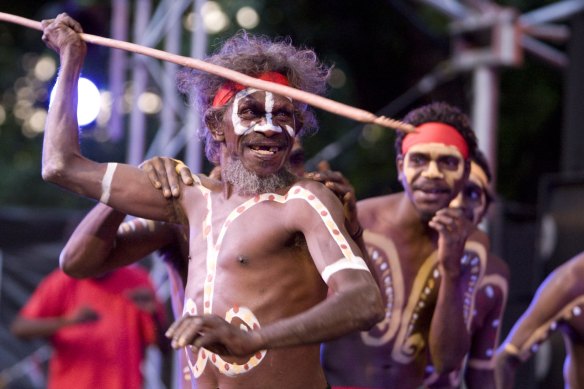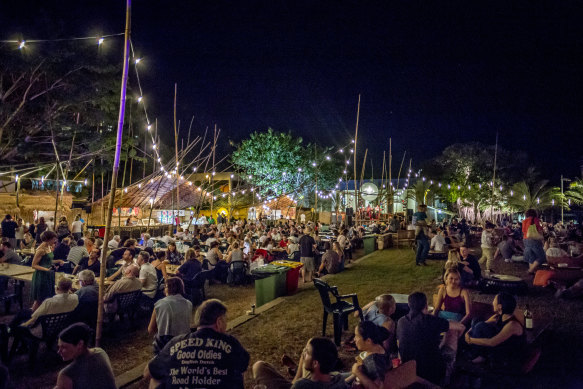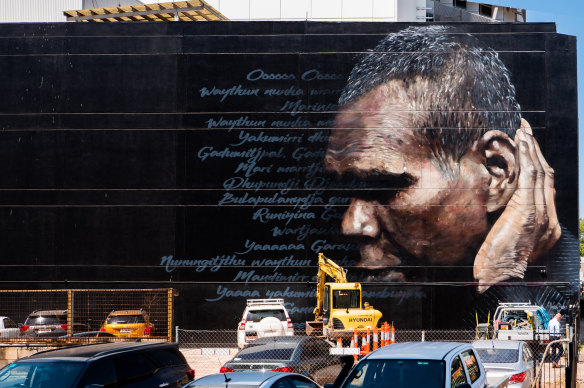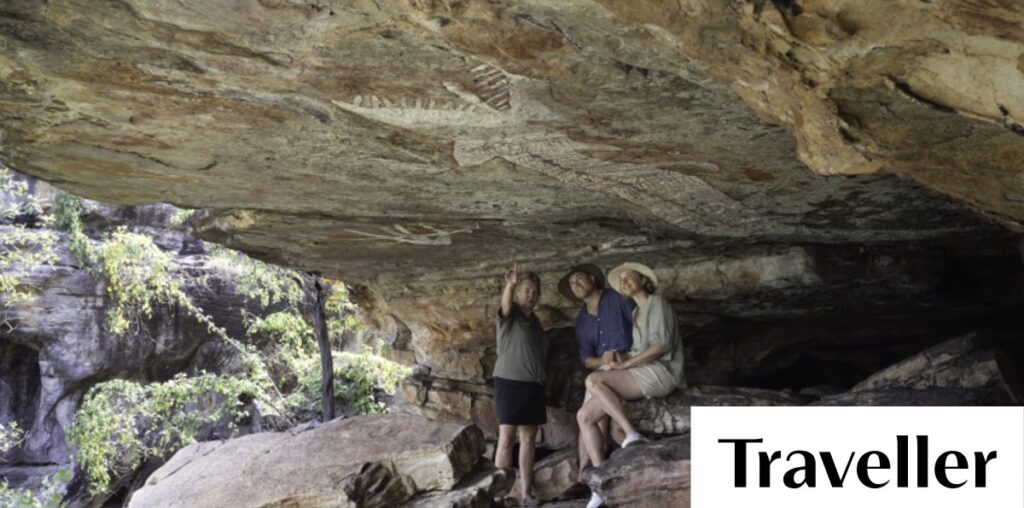Arnhem Land, named after the Dutch Ship “The Arnhem” which was blown off course in the area in 1623, is home to some of Australia’s best art, whether it be painted on rocks, bark, canvas or paper. From the moment our 22-year-old Kakadu Air pilot dodges a kangaroo hopping across the red-dirt runway to land our plane in Arnhem Land, the artwork, like the crocodiles, takes my breath away.
Even before that, I learnt coming to Darwin in early August is the peak time for lovers of Aboriginal art to visit the Territory. It’s the modern-day equivalent of going to Florence in the 15th or 16th centuries to understand Italian Renaissance art.
One of the main attractions each August is the Telstra National Aboriginal and Torres Strait Islander Art Awards (Telstra NATSIAA). Known as the “Aboriginal Archibalds”, and now in its 41st year, it is the richest, longest-running and most prestigious Aboriginal and Torres Strait Islander Art Award. This year’s $100,000 first prize went to Noli Rictor, a Pitjantjatjara man and artist from Tjuntjuntjara in Western Australia, for his synthetic polymer paint on linen piece titled Kamanti.
Rictor is considered the youngest “first contact” Aboriginal person in Australia, his family having been located by relatives in 1986 in the Great Victoria Desert of Western Australia. In his 20s, he moved from the remote desert to Yakadunya, where Spinifex people had relocated due to nuclear testing at Maralinga.
His giant work, along with the 72 other finalists will remain at the exhibition at the Museum and Art Gallery of the NT (MAGNT) until January 27, 2025. It is a Darwin “must see” for anyone interested in viewing the best of contemporary Indigenous art, as is the outdoor awards ceremony, held annually at sunset on the sprawling MAGNT lawns on an early August night.
As with the Archibald Prize, there is a NATSIAA Salon des Refuses, which this year gathered some of the 238 NATSIAA award entries not selected as finalists.
Also in August, the four-day Darwin Aboriginal Art Fair assembles art from more than 80 art centres around Australia. This is an easy one-stop shop for art lovers who want to collect work from some of Australia’s most remote Indigenous art communities. This year the fair achieved more than $4.378 million in sales, while injecting a further $11.3 million into the Northern Territory economy.
“It was designed to coincide with the NATSIAA art awards – the museum foundation board came up with the idea to connect artists to buyers,” says Claire Summers, executive director of the fair (known as DAAF, in “Darwinese”).

Not to be missed: The Darwin Festival is an Indigenous showpiece.Credit:
“It is now celebrating its 18th year – in our first year there were about 16 Northern Territory art centres participating at the event, now we have 81 centres at the fair from all over Australia – including a collective from NSW for the first time: the Malang Indigenous Corporation in Toronto.
“This fair is about access. These artists are living in some of the remotest places in Australia, let alone the world. This event, in person and online, is our way of giving over 1500 artists access to a market for their work.”
It also offers access for art buyers who perhaps don’t have the time or money to visit the art centres in places such as Arnhem Land or other NT remote communities.
All these events, now firm fixtures of the Australian arts calendar, are held under the umbrella of the Darwin Festival, now run by artistic director Kate Fell.
“I love the deep connection to community this festival has – it’s a great place to winter over,” says the Queensland-born former Brisbane Festival director.
The 18-day festival is a multi-arts festival based around a central Festival Park, with outdoor stages – including a Spiegeltent – featuring comedy, music, theatre, family shows and food.

Festival Park is the venue for the 18-day Darwin festival.Credit:
“There are about 40 venues, with 80 different events hosting 680 performances by 700 artists – about 60 per cent of them from the Northern Territory,” Fell says.
The opening weekend becomes a drawcard for anyone interested in First Nations Arts and Culture – with DAAF, the NATSIAAs and a host of galleries hosting shows too, she says.
“The festival is a broad church, but First Nations Art is a big part of our appeal,” Fell says. “There is this magical feeling you get in Darwin at this time of the year – the being outdoors, it’s kind of like Darwin’s Christmas. Everyone’s feeling really good, and when you come and visit from elsewhere you kind of get swept up in it.”
Other major artistic drawcards in August in Darwin include Country to Couture, the National Indigenous Fashion Awards for fashionistas, and for music lovers there’s the National Indigenous Music Awards. For those willing to make the 28-hour drive from Darwin to Gulkula on the Gove Peninsula, there’s also the four-day Garma festival, a celebration of Yolngu life hosted by the Yothu Yindi Foundation.
If August doesn’t suit for a visit, there’s always the Darwin Street Art Festival, held since 2017 most years in May and June, when this tropical city on Larrakia land transforms into a mecca for graffiti artists from the world over. Works by artists such as Fintan Magee, and this year’s Archibald Packing Room Prize winner Matt Adnate, adorn buildings all over the city.

Another drawcard: Darwin street art in the CBD.Credit:
“We have great art not just on rock walls but also city walls in the NT,” says Street Art Festival director Dave Collins. If you are not there at the same time as the festival, the excellent DSAF app, can direct you on a self-guided tour through the major works downtown.
For anyone wanting to escape the chilly temperatures of August in colder parts of Australia, I can’t help but echo the words of our Arnhem Land rock art guide, Ryan Paget. A Darwin winter arts and culture break never gets old.

